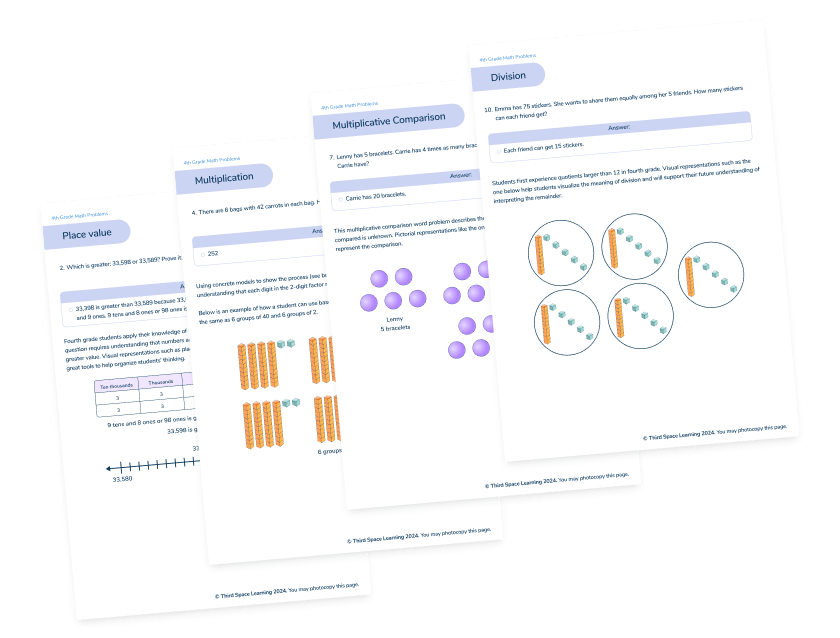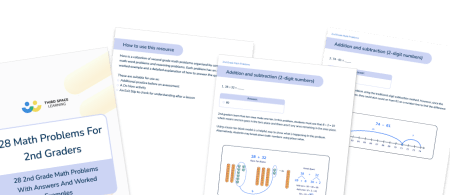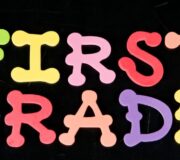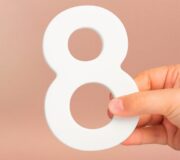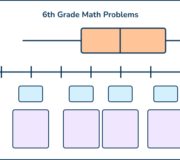28 Math Problems For 2nd Graders With Answers & Teaching Ideas
Math problems for 2nd graders bridge lower elementary and upper elementary math concepts. 2nd grade math problems focus on solidifying an understanding of place value and applying this to more complex addition and subtraction problems.
This blog post looks at the key areas for 2nd grade math problems including place value, measurement, geometry and math word problems. It aims to provide teachers with math problems, solutions and strategies for teaching 2nd grade math.
What are math problems for 2nd graders?
Math problems for 2nd graders are a type of math question designed specifically for 7-8-year-old children. They include a variety of concepts across four domains of common core math standards:
- Operations and Algebraic Thinking
- Number and Operations in Base Ten
- Measurement and Data
- Geometry
Within these domains, second grade math problems include the following 2nd grade math concepts:
- Addition and subtraction (2-digit numbers within 100) with and without regrouping
- Place value (3-digit numbers up to 1,000)
- Measurement problem solving
- Counting money
- Reading digital and analog clocks
- Basic fractions
- Geometry
- Bar graphs and picture graphs
Each concept builds on skills that students learned in kindergarten and 1st grade.
28 2nd Grade Math Problems
28 2nd grade math problems and answer key for students to solidify understanding of math concepts. Questions cover addition, subtraction, place value, measurement problems, money, time, fractions, geometry and bar graphs.
Download Free Now!Math problems for 2nd graders: Math curriculum
Second grade math is an integral part of the K-5 math progression. In kindergarten and first grade, students use knowledge of counting to learn the meaning of addition and subtraction.
Students use hands-on math manipulatives to build understanding, solve problems and build addition and subtraction fluency within 10. They are introduced to basic math word problems and learn that math is part of the real world.
By second grade, students are expected to have efficient problem-solving strategies for addition and subtraction within 20. Building on this foundation, 2nd graders use their knowledge of smaller addition and subtraction problems to help them solve problems with larger two-digit numbers.
Students may use math tools and visual models to learn more abstract and efficient math problem-solving strategies. This problem solving progression of concrete representational abstract is important at every grade level when learning new math concepts.
Second grade allows students to explore new math skills such as:
- Extend understanding of base ten to compare larger numbers up to 1,000
- Develop fluency with addition and subtraction within 100
- Describe, analyze, and partition shapes
- Understand measurement units
- Represent data using bar graphs
These 2nd grade math skills are the foundation for 3rd grade math. They help students secure their understanding of place value and apply their knowledge to larger addition and subtraction problems.
Developing knowledge of these math concepts also prepares children to learn multiplication and division skills in 3rd grade.

Meet Skye, the voice-based AI tutor making math success possible for every student.
Built by teachers and math experts, Skye uses the same pedagogy, curriculum and lesson structure as our traditional tutoring.
But, with more flexibility and a low cost, schools can scale online math tutoring to support every student who needs it.
Find out moreMath problems for 2nd graders with solutions
The following is a collection of math problems for 2nd graders organized by skill. Each problem includes an answer key, and an explanation of how to answer the math question.
Addition and subtraction (2-digit numbers)
Beginning in kindergarten children learn models for solving addition and subtraction problems. In 2nd grade, students apply this understanding to solve larger problems with two-digit numbers.
Sometimes, these problems include regrouping (or renaming), for example, exchanging one ten for ten ones or vice versa. This is a challenging idea for students, so base-ten visual models are important when teaching this new concept.
Second graders also solve addition and subtraction word problems that are more difficult than the word problems they solved in first grade.
Question 1
28 + 32 = _____
Answer: 60
2nd graders learn that ten ones make one ten. In this problem, students must see that 8 + 2 = 10 which means one ten goes in the tens place and there aren’t any ones remaining in the ones place.
Using a base-ten block model is a helpful way to show what is happening in this problem. Alternatively, students may break down both numbers using place value.
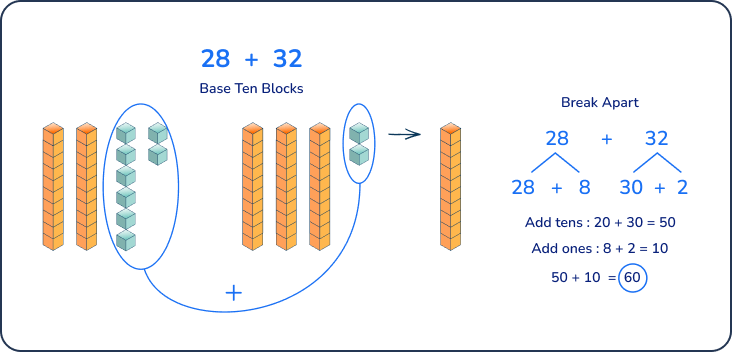
Question 2
74 – 61 = _____
Answer: 13
Students can solve this problem using the traditional digit subtraction method. However, since the numbers are relatively close, they could also count on from 61 on a number line to find the difference between 74 and 61.

Question 3
18 + _____ = 30
Answer: 12
This problem is designed as a missing addend problem. To solve this problem, students must use a subtraction strategy to find the difference between 30 and 18.
Missing addend problems help students connect subtraction to addition and encourage them to add on from the lower number.
In this case, students could subtract using the traditional standard algorithm, however, they would need to rename 30 ones as 2 tens and 10 ones. You can support this new concept in 2nd grade with base ten blocks. Adding on from 18 is likely more efficient for this particular problem.
Additionally, the unknown being to the left of the equal sign could confuse students so it is important to emphasize the meaning of the equal sign to prevent this misconception.
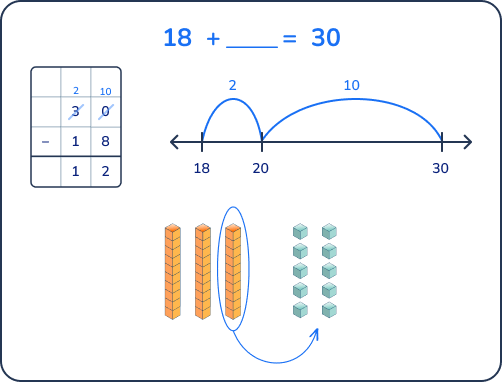
Question 4
Nadia had 24 white flowers and 19 yellow flowers growing in her garden. How many flowers did Nadia grow in her garden in total?
Answer: 43 total flowers
Drawing a visual model or using a story problem graphic organizer are great ways to build understanding of math word problems.
This problem is a part-part-whole problem so a bar model or tape diagram is a great way to visualize the unknown in the problem. Then students can use an addition strategy such as breaking apart one addend to solve.
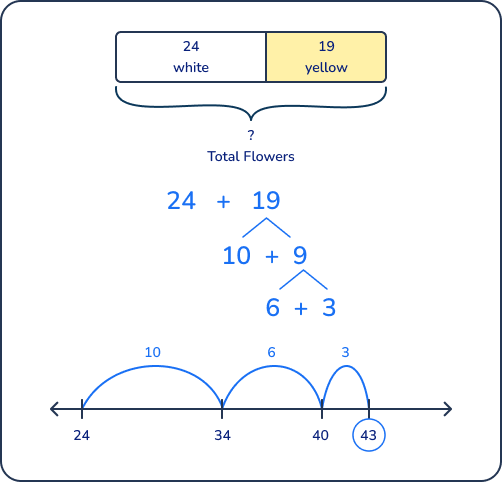
Question 5
There were 56 people at the swimming pool. 23 people left the pool after lunch. How many people were still at the pool after lunch?
Answer: 33 people remained at the pool
This is a traditional separate, result unknown problem. Because there is the action of 23 people leaving, it is easier for students to visualize the subtraction.
The traditional standard algorithm is a good method to solve this problem without any regrouping. Students can use base ten blocks to support their understanding as needed.
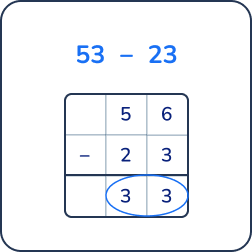
Addition and subtraction common misconceptions
Two-digit addition and subtraction introduces the added challenge of regrouping. Students often need support deciding which number needs to be regrouped.
Additionally, students often rush to using an algorithm before they have a foundation of conceptual understanding. For example, when solving 30-17, children need to be able to take one group of 10 from the 3 groups of 10 in the number 30 to use in the ones place to find the missing addend. Then they can subtract 10-7 and the remaining 2 tens – 1 ten.
Teachers can support children with this by using a base-ten visual model with blocks or a drawing. Educators can also encourage learners to try other strategies such as breaking apart the subtrahend. Breaking 17 apart into 10 and 7 allows students to subtract first, 30 – 10, and then subtract the remaining 20 – 7. They can use base ten blocks or a number line to support problem solving.
Place value (3-digit numbers)
Prior to second grade, students learn place value concepts such as the meaning of the tens-place and the ones-place in the base ten number system. They use visual models such as base ten blocks and place value charts to help understand the complex concept.
In second grade, students expand their knowledge and learn the meaning and value of the hundred and thousand places in the number system. With a secure understanding of this, second graders can then learn to compare three-digit numbers numbers up to 1,000.
Students in 2nd grade use the expanded form to represent three-digit numbers to show the meaning of each digit in the number.
Question 6
On Saturday, 346 people went to the carnival. On Sunday, 432 went to the carnival. On which day did more people go to the carnival?
Answer: On Sunday more people went to the carnival because 432 is greater than 346
Students can solve this problem by breaking down the numbers by place value, or by writing them in a place value chart and comparing starting with the largest place value first. Learners will notice 4 hundreds is more than 3 hundreds so 432 is greater than 346.
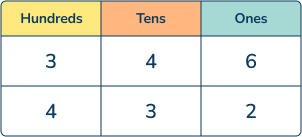
Question 7
Compare the following two numbers using the greater than, less than and/or equal to symbols (>, <, =)
624_____398
Answer: 624 > 398
Writing both numbers in expanded form helps students compare the values. Even though 398 has a larger number in the tens place and in the ones place, it has fewer hundreds than 624. Therefore 624 is greater than 398.
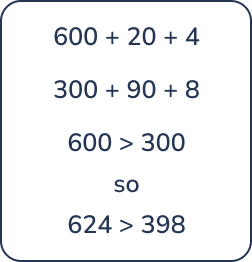
Question 8
How many hundreds are in the number 462? Explain your thinking.
Answer: 4 hundreds
Building a number using base ten blocks is a concrete method for students to understand the number of hundreds, tens and ones in a number. Using base ten blocks or a quick picture helps students see there are 4 hundreds in the number 462.
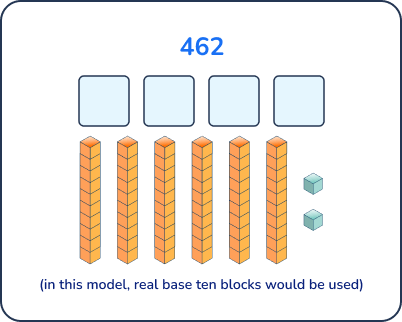
Question 9
Write the number 684 in expanded form.
Answer: 600 + 80 + 4
Writing answers in the expanded form is straightforward. Students should break up the number using place value.
A place value chart can help to organize student thinking when breaking up the numbers. As an additional challenge, students can write this number as 680 + 4 or 600 + 84.
Common place value misconceptions
Working with three digits is new for 2nd grade students. Often, in a number such as 273, they see that the number 7 is seemingly the largest. So in comparing 273 to 341, they might say that 273 is the bigger number because 7 is greater than any digits in the other number, even though 341 is greater than 273.
Students must learn the value of each digit and compare numbers using the largest place value first. Teachers can encourage students to write numbers in expanded form (200 + 70 + 3), and use base-ten blocks to model the numbers. Place value charts are another helpful tool to clear up this misconception.
Measurement: problem solving and word problems
In kindergarten and first grade, children learn basic measurement concepts such as describing measurable attributes of objects and using basic measurement units.
In second grade, children learn to use standard units of measure. They also discover various real-world contexts for measurement as they solve measurement word problems. 2nd grade measurement word problems include addition and subtraction of double-digit numbers.
Question 10
Josh and Simone were training for a marathon. Josh ran 22 miles on Saturday. Simone ran 16 miles on Saturday. How many more miles did Josh run than Simone on Saturday?
Answer: 6 more miles
Learners can solve this problem by counting on from 16 to 22 or subtracting back from 22 to 16. Students may also use a standard algorithm although it would require regrouping and might be less efficient.
Using a number line or bar model is a helpful visual for students to understand that in this problem they need to find the difference between 16 and 22.
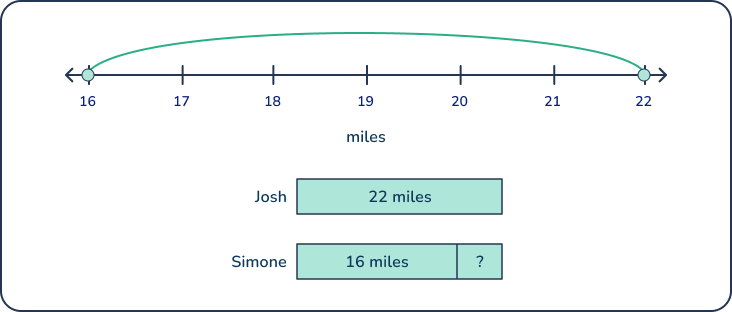
Question 11
The maple tree is 72 inches tall. The oak tree is 13 inches taller than the maple tree. How tall is the oak tree?
Answer: 85 inches tall
Measuring height is a context that second graders often see in measurement problems. Using a vertical number line is a helpful visual model for students to recognize that they are adding 13 to 72 in this word problem. Then they can choose a solution strategy to find the sum.
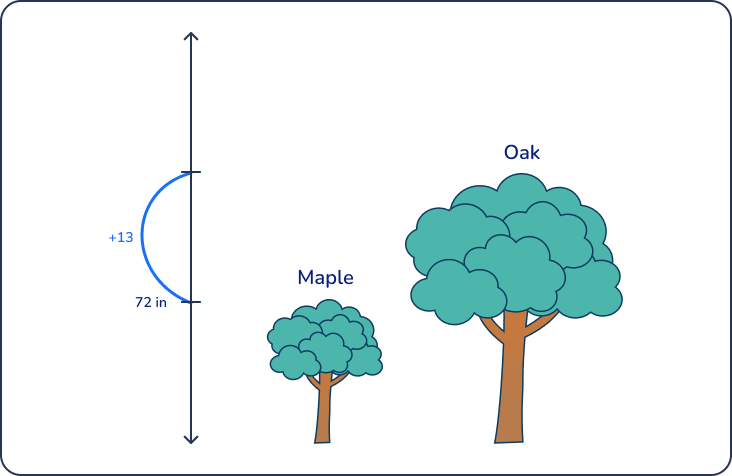
Question 12
The Rodrigo family went on a road trip. In the first hour, they drove 55 miles. In the second hour, they drove 42 miles. How many miles did the Rodrigo family drive in the first two hours of their trip?
Answer: 97 miles
In this math word problem, learners could use a bar model to visualize adding 55 and 42. They can then choose a strategy to find the sum, such as adding with place value or breaking apart one addend.
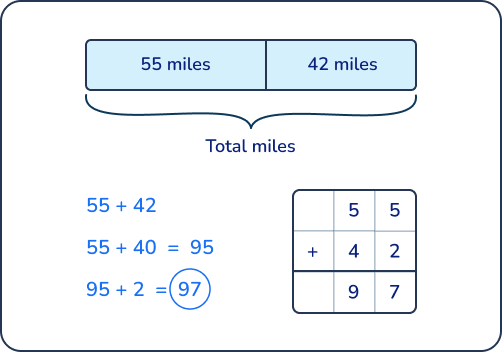
Money
Second grade is the first time that students are introduced to counting money. Students learn the value of each coin and the dollar bill. Children solve word problems to determine total quantities when coins are put together and taken apart. This sets the foundation for learning about decimals in the base-ten number system, which is introduced in 4th grade, 5th grade and 6th grade.
Question 13
The picture below shows how much money my sister has in her piggy bank. How many cents does my sister have in her piggy bank?
Answer: 89 cents
To add the value of the coins together, students should find the total value of all the coins of one type first, or find ways to make ten.
In this case, they would see that there are 2 quarters (50 cents), 2 dimes (20 cents), 3 nickels (15 cents) and 4 pennies (4 cents) so a total of 89 cents.

Question 14
William has 3 quarters. Margaret has 8 pennies. Who has more money? Explain.
Answer: William has more money because 75 cents is more than 8 cents
This problem is challenging for students because the number 8 has a larger value than the number 3. Students should label their work and use real coins where possible to build meaning.
Skip counting or repeated addition can help students see William has 75 cents and Margaret has 8 cents.
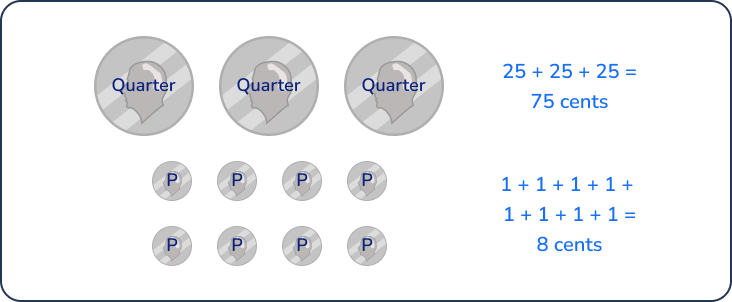
Question 15
Mr. Hopkins had a lemonade sale. He sold 2 cups of lemonade and got 1 quarter, 2 dimes and 1 nickel. How much money did Mr. Hopkins make from selling 2 cups of lemonade?
Answer: 50 cents
Writing an equation to match a hands-on model with coins or a pictorial model with labels is a great way for students to visualize which numbers they are adding.
At the second grade level, students do not necessarily write these numbers as decimals since they don’t add decimals until 4th and 5th grade. However, teachers can address what these numbers would look like if we wrote them using decimal notation.
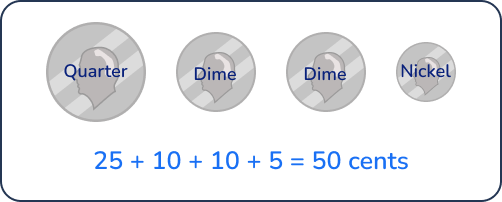
Reading digital and analog clocks
Telling time was a new skill for students in 1st grade. They learned to read digital and analog clocks to the nearest hour and a half hour. In 2nd grade, students dive deeper and learn to read digital and analog clocks to the nearest 5 minutes, using both a.m. and p.m.
Question 16
What time is shown on the analog clock below? Write your answer in digital clock format.
Answer: 4:40
As 2nd grade students learn about clocks, they must realize that the hour hand moves throughout the hour as well as the minute hand.
In this situation, the hour hand is closer to 5 than 4 because it is past the half hour. Practicing with hands-on clocks helps children understand this concept.
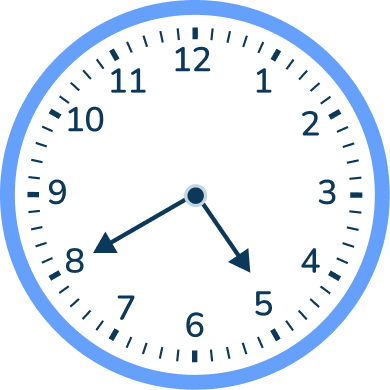
Question 17
Lucy’s dance class starts at 5:15pm. Circle the clock that shows the time her dance class starts.
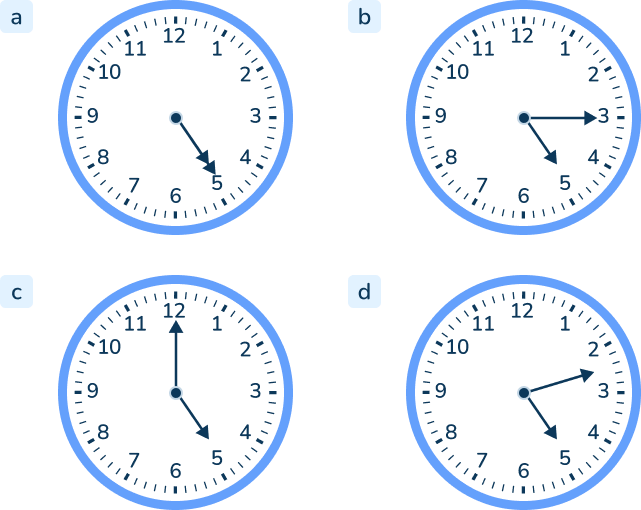
Answer: B
Students must recognize the short hand as the hour hand and the long hand as the minute hand. Many students may confuse D as the correct answer when it shows 5:12.
Teachers can facilitate connections between digital and analog clock times using a visual timeline or schedule throughout the day.
Question 18
Lee woke up earlier than Timothy. If Timothy woke up at 6:00am, what time could Lee have woken up? Choose from the digital 24-hour clocks below.
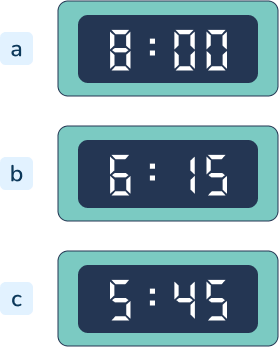
Answer: C
The concept of earlier and later is a fairly new concept for 2nd graders when considering time. Math problems like this prepare students for elapsed time problems in 3rd grade.
In this problem, students must recognize that 5:00 am comes before 6:00 am, therefore 5:45 am is earlier than 6:00 am.
Common time misconceptions:
Students often confuse the hour and the minute hands on an analog clock. They need a lot of repeated practice to build understanding.
Fractions
2nd grade introduces students to the foundation of fractions and connects fractions to geometry.
Students learn to partition rectangles and circles into two, three and four equal shares. They connect the size of these shares to the vocabulary half, third and fourth, setting the foundation for harder fractions in 3rd grade.
Question 19
If 4 friends share a pizza and each friend gets an equal share, what fraction of the whole pizza does each friend get?
Answer: \frac{1}{4} of the whole pizza
Using visual models that students can draw on, cut and fold is critical for building a conceptual understanding of fractions.
Children should fold a circular piece of paper or draw a circle and ‘cut’ it into fourths by drawing lines. They may also physically model it using a real pizza or play pizza. The aim is to connect the vocabulary of ‘one-fourth’ when sharing something equally with 4 people.
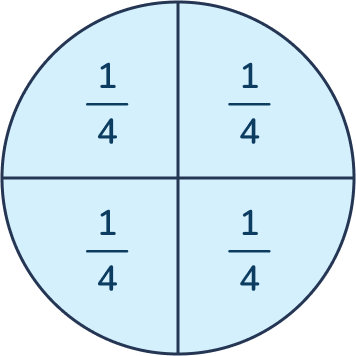
Question 20
Which models below show a rectangle being partitioned into fourths? Select all that apply.
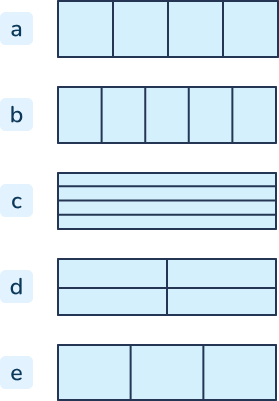
Answer: A,C,D
This math problem shows students that rectangles and other shapes can be partitioned in multiple ways.
As long as the size of the 4 pieces are equal, all three of these models represent a rectangle partitioned into fourths.
If students answer B, they might not understand how to draw fourths. This misconception indicates that they think drawing 4 lines partitions into fourths, rather than fifths.
Question 21
If you slice a pie down the middle so that each side is the same size, what fraction of the whole pie is each side?
Answer: One half or \frac{1}{2}
Emphasizing the same-size parts is important for setting the foundation for fraction concepts in third grade and beyond. Because of this, 2nd grade fraction concepts focus heavily on vocabulary and equal shares.
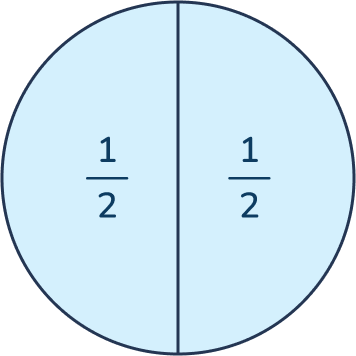
Geometry
In kindergarten and first grade math, students learn the defining attributes of various two-dimensional and three-dimensional shapes. In second grade math, students solidify their understanding of some basic 2-D and 3-D shapes and draw and identify the number of sides and angles for each shape including:
- Types of triangles
- Quadrilaterals
- Pentagons
- Hexagons
- Cubes
Question 22
Draw a closed shape that has 6 sides. What is the name of the shape?
Answer: Drawings may vary but should all have 6 sides and 6 angles. This shape is called a hexagon.
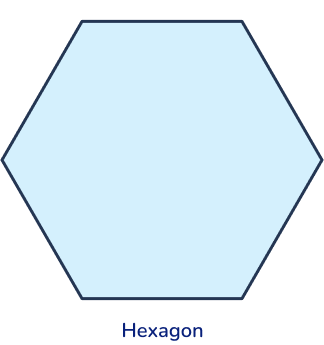
Question 23
Which shape below is a pentagon? Explain how you know.
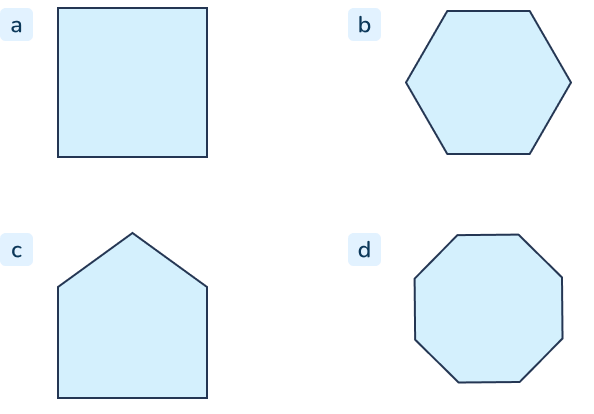
Answer: C
A pentagon has 5 sides and shape C is the only 5-sided figure.
Question 24
What is the name of a shape with 3 angles? Draw a picture of this shape.
Answer: Triangle
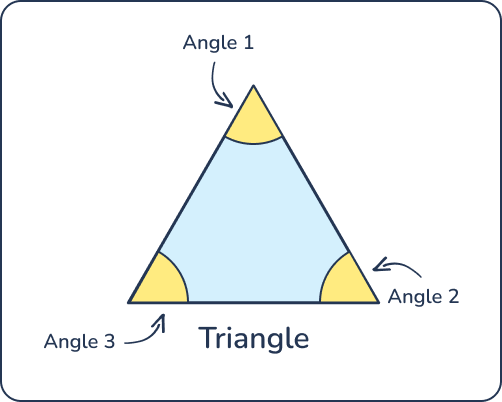
Question 25
Draw a quadrilateral. How many angles are in a quadrilateral?
Answer: Drawings will vary but should be closed 4-sided shapes. There are 4 angles in a quadrilateral.

Bar graphs
Before 2nd grade, students learned to informally organize and represent data. In second grade, students learn a more formal method to represent data: a bar graph.
2nd grade students must know how to represent data using a bar graph and/or a picture graph and solve simple problems using data presented in bar graphs.
Question 26
In a class survey, the students in Mrs. Nielsen’s class voted for their favorite color. The data is represented in the bar graph below. How many more students voted for blue than voted for green?
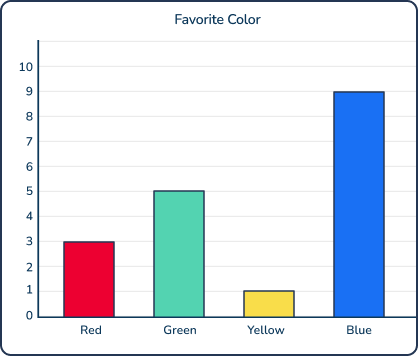
Answer: 4 more students voted for blue
Since 9 students voted for blue and 5 students voted for green, the difference is 4 students.
Students must be able to read the bar graph and analyze the data to find the difference.
Question 27
Look at the bar graph. How many total people ordered food at Pat’s Diner over the weekend?
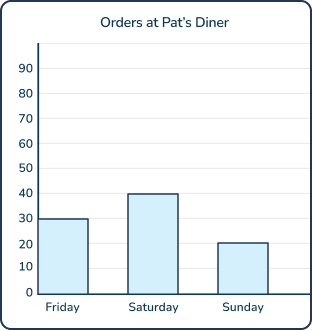
Answer: 90 people ordered food
2nd graders need to understand the scale on the graph. In this math problem, the scale is 10. Children should see there were 30 orders on Friday, 40 on Saturday and Sunday there were 20 and know to add those three values together.
Question 28
How many fewer cats are there at the shelter than dogs? Use the bar graph below to answer the question.
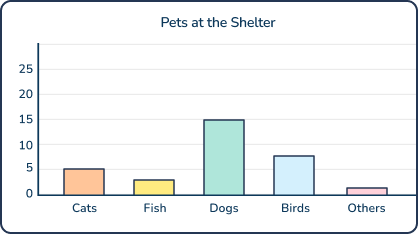
Answer: 10 fewer cats than dogs
2nd graders learn about the parts of a bar graph, including the:
- Scale
- Axis
- Title
- Labels
There is a lot of information provided about all the animals at the shelter, students must identify the information in the problem and then solve the problem using the information.
In this case, there are 5 cats at the shelter and 15 dogs, so the difference is 10.
You may also represent this bar graph horizontally.
3 top tips for teaching 2nd grade math problems
Teaching 2nd grade math relies on visual models to help students build understanding and develop efficient problem solving strategies.
To help 2nd grade students build an understanding of new math concepts these elementary teaching best practices can help:
- Teach students more than one method to solve a problem. They can then decide which strategy is most efficient. For example, base-ten blocks, a number line, breaking apart one addend, breaking apart both addends or the standard algorithm.
- Use visual models such as a base-ten block to build an understanding of regrouping when adding and subtracting.
- Follow the CRA progression and transition from hands-on concrete models, to representational or pictorial models, to abstract models.
How can Third Space Learning help with 2nd grade math?
Help your youngest learners build math confidence with one-on-one support that speaks and listens like a real tutor. Skye, the elementary math tutor built by teachers, helps to close learning gaps and address misconceptions for struggling 2nd grade math students. Voice-based conversational elementary math instruction helps students deepen their understanding of the math curriculum and keep up with difficult math concepts.
Each student works one to one with Skye, the AI math tutor, with the instruction and lesson content adapted in real-time according to the student’s needs.
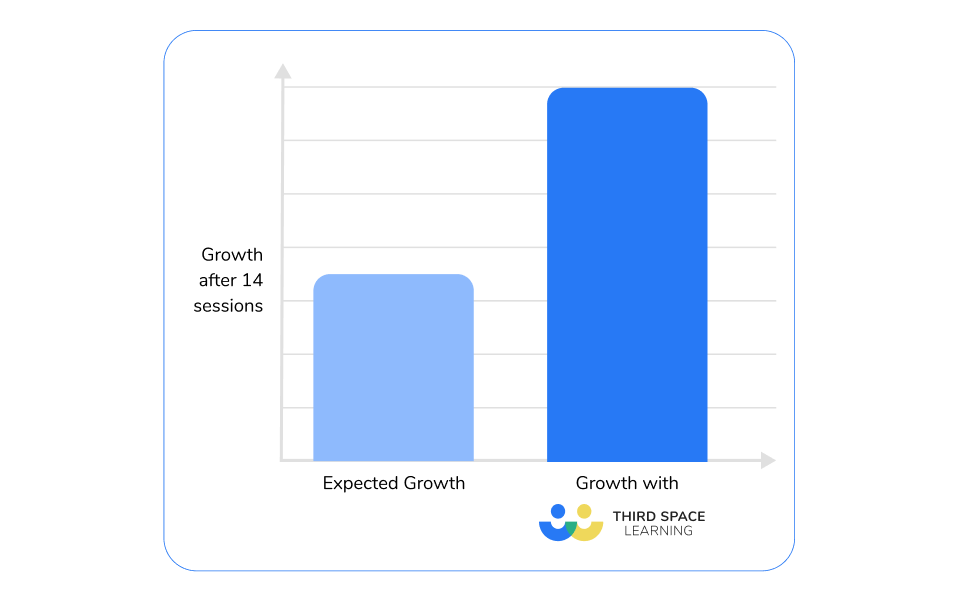
2nd grade math worksheets and resources
Looking for more resources? Check out our math games and selection of second grade addition and subtraction worksheets, posters and activities covering the key 2nd grade math topics and more:
- 2nd Grade Fractions Error Analysis
- 2nd Grade Addition and Subtraction Code Crackers
- Addition And Subtraction Word Problems
- Summer Math Activities For 1st and 2nd Grade
- 25 Fun Math Problems
Do you have students who need extra support in math?
Skye—our AI math tutor built by experienced teachers—provides students with personalized one-on-one, spoken instruction that helps them master concepts, close skill gaps, and gain confidence.
Since 2013, we’ve delivered over 2 million hours of math lessons to more than 170,000 students, guiding them toward higher math achievement.
Discover how our AI math tutoring can boost student success, or see how our math programs can support your school’s goals:
– 3rd grade tutoring
– 4th grade tutoring
– 5th grade tutoring
– 6th grade tutoring
– 7th grade tutoring
– 8th grade tutoring
